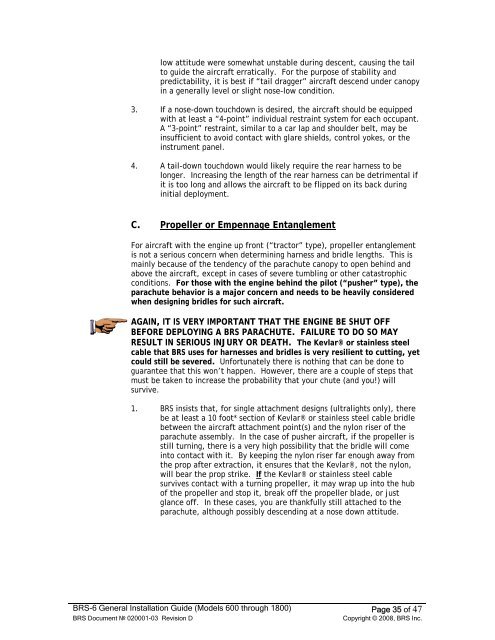BRS-6 General Installation Guide - CAFE Foundation
BRS-6 General Installation Guide - CAFE Foundation
BRS-6 General Installation Guide - CAFE Foundation
You also want an ePaper? Increase the reach of your titles
YUMPU automatically turns print PDFs into web optimized ePapers that Google loves.
low attitude were somewhat unstable during descent, causing the tail<br />
to guide the aircraft erratically. For the purpose of stability and<br />
predictability, it is best if “tail dragger” aircraft descend under canopy<br />
in a generally level or slight nose-low condition.<br />
3. If a nose-down touchdown is desired, the aircraft should be equipped<br />
with at least a “4-point” individual restraint system for each occupant.<br />
A “3-point” restraint, similar to a car lap and shoulder belt, may be<br />
insufficient to avoid contact with glare shields, control yokes, or the<br />
instrument panel.<br />
4. A tail-down touchdown would likely require the rear harness to be<br />
longer. Increasing the length of the rear harness can be detrimental if<br />
it is too long and allows the aircraft to be flipped on its back during<br />
initial deployment.<br />
C. Propeller or Empennage Entanglement<br />
For aircraft with the engine up front (“tractor” type), propeller entanglement<br />
is not a serious concern when determining harness and bridle lengths. This is<br />
mainly because of the tendency of the parachute canopy to open behind and<br />
above the aircraft, except in cases of severe tumbling or other catastrophic<br />
conditions. For those with the engine behind the pilot (“pusher” type), the<br />
parachute behavior is a major concern and needs to be heavily considered<br />
when designing bridles for such aircraft.<br />
AGAIN, IT IS VERY IMPORTANT THAT THE ENGINE BE SHUT OFF<br />
BEFORE DEPLOYING A <strong>BRS</strong> PARACHUTE. FAILURE TO DO SO MAY<br />
RESULT IN SERIOUS INJURY OR DEATH. The Kevlar® or stainless steel<br />
cable that <strong>BRS</strong> uses for harnesses and bridles is very resilient to cutting, yet<br />
could still be severed. Unfortunately there is nothing that can be done to<br />
guarantee that this won’t happen. However, there are a couple of steps that<br />
must be taken to increase the probability that your chute (and you!) will<br />
survive.<br />
1. <strong>BRS</strong> insists that, for single attachment designs (ultralights only), there<br />
be at least a 10 foot* section of Kevlar® or stainless steel cable bridle<br />
between the aircraft attachment point(s) and the nylon riser of the<br />
parachute assembly. In the case of pusher aircraft, if the propeller is<br />
still turning, there is a very high possibility that the bridle will come<br />
into contact with it. By keeping the nylon riser far enough away from<br />
the prop after extraction, it ensures that the Kevlar®, not the nylon,<br />
will bear the prop strike. If the Kevlar® or stainless steel cable<br />
survives contact with a turning propeller, it may wrap up into the hub<br />
of the propeller and stop it, break off the propeller blade, or just<br />
glance off. In these cases, you are thankfully still attached to the<br />
parachute, although possibly descending at a nose down attitude.<br />
<strong>BRS</strong>-6 <strong>General</strong> <strong>Installation</strong> <strong>Guide</strong> (Models 600 through 1800) Page 35 of 47<br />
<strong>BRS</strong> Document № 020001-03 Revision D Copyright © 2008, <strong>BRS</strong> Inc.

















